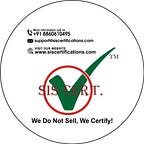How can I start implementing ISO 45001?
Implementing ISO 45001 requires a systematic approach to establish an effective Occupational Health and Safety Management System (OH&S) within your organization. Here are the key steps to start implementing ISO 45001:
Management Commitment: Obtain commitment and support from top management for implementing ISO 45001 OHSMS. Management buy-in is crucial for the success of the implementation process.
Understand the Standard: Familiarize yourself and your team with the requirements of ISO 45001. Read the standard thoroughly to gain a clear understanding of its principles and provisions.
Scope and Objectives: Define the scope of your OH&S management system. Identify the areas, processes, and activities to be covered by ISO 45001. Establish OH&S objectives and targets aligned with the organization’s overall goals.
Establish a Project Team: Form a project team responsible for implementing ISO 45001. Include representatives from different departments to ensure comprehensive coverage.
Conduct a Gap Analysis: Assess your current OH&S practices against the requirements of ISO 45001. Identify areas of non-compliance and determine what needs to be improved or established.
OH&S Policy: Develop an OH&S policy that reflects the organization’s commitment to health and safety. The policy should be concise, measurable, and communicated throughout the organization.
Risk Assessment and Controls: Identify OH&S hazards and assess associated risks. Implement controls to prevent or minimize risks, considering elimination, substitution, engineering controls, administrative controls, and personal protective equipment (PPE).
Documentation: Develop the necessary documentation, including procedures, work instructions, forms, and records, to support the OH&S management system.
Training and Awareness: Provide training to employees and relevant stakeholders on the OH&S management system, including their roles and responsibilities in maintaining a safe work environment.
Internal Communication: Establish effective communication channels for OH&S matters. Encourage open communication about safety concerns and incidents.
Emergency Preparedness: Develop and test emergency response procedures to handle potential incidents effectively.
Internal Audit: Conduct internal audits to assess the effectiveness and compliance of your OH&S management system. Address any non-conformities identified during the audit.
Management Review: Hold regular management reviews to evaluate the performance of the OH&S management system, assess the achievement of objectives, and identify areas for improvement.
Continuous Improvement: Encourage a culture of continuous improvement in OH&S. Implement corrective actions to address non-conformities and enhance the effectiveness of the OH&S management system.
External Certification: Once your OH&S management system is fully implemented and has been running effectively, you can engage an accredited certification body to conduct an external audit for ISO 45001 certification.
Remember that ISO 45001 implementation is an ongoing process that requires dedication, participation, and collaboration from all levels of the organization. Regular monitoring and evaluation of your OH&S management system will help you identify opportunities for improvement and ensure a safer work environment for employees and stakeholders.
